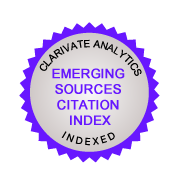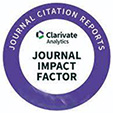Iron-Binding Capacity and Antidiabetic Activity of Baby Clam (Corbiculidae sp.) Meat Protein Hydrolysate
Tam Dinh Le Vo(1*), Thu Huynh(2), Thuy Thi Le(3), An Thi Tuong Tran(4), Bao Chi Vo(5)
(1) Department of Food Technology, Faculty of Chemical Engineering, Ho Chi Minh City University of Technology, 268 Ly Thuong Kiet Street, District 10, Ho Chi Minh City 700000, Vietnam; Vietnam National University Ho Chi Minh City, Linh Trung Ward, Thu Duc City, Ho Chi Minh City 700000, Vietnam
(2) Vietnam National University Ho Chi Minh City, Linh Trung Ward, Thu Duc City, Ho Chi Minh City 700000, Vietnam; Department of Biotechnology, Faculty of Chemical Engineering, Ho Chi Minh City University of Technology, 268 Ly Thuong Kiet Street, District 10, Ho Chi Minh City 700000, Vietnam
(3) Department of Food Technology, Faculty of Chemical Engineering, Ho Chi Minh City University of Technology, 268 Ly Thuong Kiet Street, District 10, Ho Chi Minh City 700000, Vietnam; Vietnam National University Ho Chi Minh City, Linh Trung Ward, Thu Duc City, Ho Chi Minh City 700000, Vietnam
(4) Department of Food Technology, Faculty of Chemical Engineering, Ho Chi Minh City University of Technology, 268 Ly Thuong Kiet Street, District 10, Ho Chi Minh City 700000, Vietnam; Vietnam National University Ho Chi Minh City, Linh Trung Ward, Thu Duc City, Ho Chi Minh City 700000, Vietnam
(5) Department of Food Technology, Faculty of Chemical Engineering, Ho Chi Minh City University of Technology, 268 Ly Thuong Kiet Street, District 10, Ho Chi Minh City 700000, Vietnam; Vietnam National University Ho Chi Minh City, Linh Trung Ward, Thu Duc City, Ho Chi Minh City 700000, Vietnam
(*) Corresponding Author
Abstract
Keywords
Full Text:
Full Text PDFReferences
[1] Vo, T.D.L., Pham, K.T., Le, V.M.V., Lam, H.H., Huynh, O.N., and Vo, B.C., 2020, Evaluation of iron-binding capacity, amino acid composition, functional properties of Acetes japonicus proteolysate and identification of iron-binding peptides, Process Biochem., 91, 374–386.
[2] Zhang, Y.Y., Stockmann, R., Ng, K., Broadbent, J.A., Stockwell, S., Suleria, H., Karishma Shaik, N.E., Unnithan, R.R., and Ajlouni, S., 2023, Characterization of Fe(III)-binding peptides from pea protein hydrolysates targeting enhanced iron bioavailability, Food Chem., 405, 134887.
[3] Gómez-Grimaldos, N.A., Gómez-Sampedro, L.J., Zapata-Montoya, J.E., López-García, G., Cilla, A., and Alegría-Torán, A., 2020, Bovine plasma hydrolysates’ iron chelating capacity and its potentiating effect on ferritin synthesis in Caco-2 cells, Food Funct., 11 (12), 10907–10912.
[4] Fan, C., Ge, X., Hao, J., Wu, T., Liu, R., Sui, W., Geng, J., and Zhang, M., 2023, Identification of high iron–chelating peptides with unusual antioxidant effect from sea cucumbers and the possible binding mode, Food Chem., 399, 133912.
[5] Xue, D., Jiang, S., Zhang, M., Shan, K., Lametsch, R., and Li, C., 2024, The efficiency and safety evaluation of hemoglobin hydrolysate as a non-heme iron fortifier, Food Sci. Hum. Wellness, 13 (2), 999–1010.
[6] Qiao, H., Bi, X., Zhang, Y., Liu, M., Zu, S., Jia, N., Jiang, S., Lu, Q., Zu, Y., and Bao, Y., 2020, Enzymic polypeptide antioxidant activity and inhibitory activity on α-glucosidase and α-amylase from Paeonia ostii cake, Ind. Crops Prod., 146 112158.
[7] Zhao, Q., Wei, G., Li, K., Duan, S., Ye, R., and Huang, A., 2022, Identification and molecular docking of novel α-glucosidase inhibitory peptides from hydrolysates of Binglangjiang buffalo casein, LWT-Food Sci. Technol., 156, 113062.
[8] Ibrahim, M.A., Bester, M.J., Neitz, A.W.H., and Gaspar, A.R.M., 2018, Structural properties of bioactive peptides with α-glucosidase inhibitory activity, Chem. Biol. Drug Des., 91 (2), 370–379.
[9] González-Montoya, M., Hernández-Ledesma, B., Mora-Escobedo, R., and Martínez-Villaluenga, C., 2018, Bioactive peptides from germinated soybean with anti-diabetic potential by inhibition of dipeptidyl peptidase-IV, α-amylase, and α-glucosidase enzymes, Int. J. Mol. Sci., 19 (10), 2883.
[10] Balderas-León, I., Baigts-Allende, D., and Cardador-Martínez, A., 2021, Antioxidant, angiotensin-converting enzyme, and α-amylase inhibitory activities of protein hydrolysates of Leucaena leucocephala seeds, CYTA - J. Food, 19 (1), 349–359.
[11] Vo Dinh Le, T., Tran Cao, M., Le Duc, H., Duong Lap, K., and Nguyen Ngoc Quynh, A., 2021, Investigation of antioxidant activity of protein hydrolysate derived from baby clam (Corbiculidae sp.) broth, CTU J. Innovation Sustainable Dev., 13 (1), 17–23.
[12] Karami, Z., Butkinaree, C., Yingchutrakul, Y., Simanon, N., and Duangmal, K., 2022, Comparative study on structural, biological and functional activities of hydrolysates from Adzuki bean (Vigna angularis) and mung bean (Vigna radiata) protein concentrates using Alcalase and Flavourzyme, Food Res. Int., 161, 111797.
[13] Islam, M.S., Wang, H., Admassu, H., Sulieman, A.A., and Wei, F.A., 2022, Health benefits of bioactive peptides produced from muscle proteins: Antioxidant, anti-cancer, and anti-diabetic activities, Process Biochem., 116, 116–125.
[14] Latimer, G.W., 2023, Official Methods of Analysis, 22nd Edition, Oxford University Press, UK.
[15] Nwachukwu, I.D., and Aluko, R.E., 2019, A systematic evaluation of various methods for quantifying food protein hydrolysate peptides, Food Chem., 270, 25–31.
[16] Admassu, H., Gasmalla, M.A.A., Yang, R., and Zhao, W., 2018, Identification of bioactive peptides with α-amylase inhibitory potential from enzymatic protein hydrolysates of red seaweed (Porphyra spp), J. Agric. Food Chem., 66 (19), 4872–4882.
[17] Pantoa, T., Kubota, M., Suwannaporn, P., and Kadowaki, M., 2020, Characterization and bioactivities of young rice protein hydrolysates, J. Cereal Sci., 95, 103049.
[18] Arise, R.O., Idi, J.J., Mic-Braimoh, I.M., Korode, E., Ahmed, R.N., and Osemwegie, O., 2019, In vitro Angiotesin-1-converting enzyme, α-amylase and α-glucosidase inhibitory and antioxidant activities of Luffa cylindrical (L.) M. Roem seed protein hydrolysate, Heliyon, 5 (5), e01634.
[19] Berraquero-García, C., Almécija, M.C., Guadix, E.M., and Pérez-Gálvez, R., 2022, Valorisation of blood protein from livestock to produce haem iron-fortified hydrolysates with antioxidant activity, Int. J. Food Sci. Technol., 57 (4), 2479–2486.
[20] Athira, S., Mann, B., Sharma, R., Pothuraju, R., and Bajaj, R.K., 2021, Preparation and characterization of iron-chelating peptides from whey protein: An alternative approach for chemical iron fortification, Food Res. Int., 141, 110133.
[21] Senadheera, T.R.L., Dave, D., and Shahidi, F., 2021, Antioxidant potential and physicochemical properties of protein hydrolysates from body parts of North Atlantic Sea cucumber (Cucumaria frondosa), Food Prod., Process. Nutr., 3 (1), 3.
[22] Wu, W., Jia, J., Wen, C., Yu, C., Zhao, Q., and Hu, J., 2021, Optimization of ultrasound assisted extraction of abalone viscera protein and its effect on the iron-chelating activity, Ultrason. Sonochem., 77, 105670.
[23] Vo, T.D.L., Tran, T.N., Vo, B.C., Tran, M.C., Nguyen, Q.V.N., Nguyen, B.N., Le, T.M.X., Bui, N.H.Y., and Nguyen, H.T.N., 2023, Preparation, amino acid composition, peptide fractionation, thermal and pH activity stability of featherback (Chitala ornata) skin gelatin hydrolysate with zinc-binding capacity, Chem. Eng. Trans., 106, 871–876.
[24] Dong, S., Zeng, M., Wang, D., Liu, Z., Zhao, Y., and Yang, H., 2008, Antioxidant and biochemical properties of protein hydrolysates prepared from Silver carp (Hypophthalmichthys molitrix), Food Chem., 107 (4), 1485–1493.
[25] Supawong, S., Thawornchinsombut, S., and Park, J.W., 2018, Controlling lipid oxidation and volatile compounds in frozen fried fish cake prepared with rice bran hydrolysate, J. Aquat. Food Prod. Technol., 27 (8), 885–899.
[26] da Silva Bambirra Alves, F.E., Carpiné, D., Teixeira, G.L., Goedert, A.C., de Paula Scheer, A., and Ribani, R.H., 2021, Valorization of an abundant slaughterhouse by‑product as a source of highly technofunctional and antioxidant protein hydrolysates, Waste Biomass Valorization, 12 (1), 263–279.
[27] Vo, T.D.L., Pham, K.T., and Doan, K.T., 2021, Identification of copper-binding peptides and investigation of functional properties of Acetes japonicus proteolysate, Waste Biomass Valorization, 12 (3), 1565–1579.
[28] Wu, D., Cao, Y., Su, D., Karrar, E., Zhang, L., Chen, C., Deng, N., Zhang, Z., Liu, J., Li, G., and Li, J., 2024, Preparation and identification of antioxidant peptides from Quasipaa spinosa skin through two-step enzymatic hydrolysis and molecular simulation, Food Chem., 445, 138801.
[29] Salami, S.A., Osukoya, O.A., Adewale, O.B., Odekanyin, O., Obafemi, T.O., and Kuku, A., 2023, Bioactivities of Garcinia kola enzymatic hydrolysates at different enzyme–substrate ratios, AMB Express, 13 (1), 78.
[30] Dhanabalan, V., Xavier, M., Kannuchamy, N., Asha, K.K., Singh, C.B., and Balange, A., 2017, Effect of processing conditions on degree of hydrolysis, ACE inhibition, and antioxidant activities of protein hydrolysate from Acetes indicus, Environ. Sci. Pollut. Res., 24 (26), 21222–21232.
[31] Liu, Y., Wang, Z., Kelimu, A., Korma, S.A., Cacciotti, I., Xiang, H., and Cui, C., 2023, Novel iron-chelating peptide from egg yolk: Preparation, characterization, and iron transportation, Food Chem.: X, 18, 100692.
[32] Zhang, Y., Ding, X., and Li, M., 2021, Preparation, characterization and in vitro stability of iron-chelating peptides from mung beans, Food Chem., 349, 129101.
[33] Wu, W., Li, B., Hou, H., Zhang, H., and Zhao, X., 2017, Identification of iron-chelating peptides from Pacific cod skin gelatin and the possible binding mode, J. Funct. Foods, 35, 418–427.
[34] Jiang, H., Zhang, W., Chen, F., Zou, J., Chen, W., and Huang, G., 2019, Purification of an iron‐binding peptide from scad (Decapterus maruadsi) processing by‐products and its effects on iron absorption by Caco‐2 cells, J. Food Biochem., 43 (7), e12876.
[35] Vo, T.D.L., Lam, H.H., Huynh, O.N., and Nguyen, D.T.M., 2020, Investigation of calcium-binding capacity and functional properties of Acetes japonicus protein hydrolysate, Chem. Eng. Trans., 78, 349–354.
[36] Wang, J., Wu, T., Fang, L., Liu, C., Liu, X., Li, H., Shi, J., Li, M., and Min, W., 2020, Anti-diabetic effect by walnut (Juglans mandshurica Maxim.)-derived peptide LPLLR through inhibiting α-glucosidase and α-amylase, and alleviating insulin resistance of hepatic HepG2 cells, J. Funct. Foods, 69, 103944.
[37] Feng, J., Ma, Y.L., Sun, P., Thakur, K., Wang, S., Zhang, J.G., and Wei, Z.J., 2021, Purification and characterization of α-glucosidase inhibitory peptides from defatted camellia seed cake, Int. J. Food Sci. Technol., 56 (1), 138–147.
[38] Mojica, L., and de Mejía, E.G., 2016, Optimization of enzymatic production of anti-diabetic peptides from black bean (Phaseolus vulgaris L.) proteins, their characterization and biological potential, Food Funct., 7 (2), 713–727.
[39] Ding, J., Liang, R., Yang, Y., Sun, N., and Lin, S., 2020, Optimization of pea protein hydrolysate preparation and purification of antioxidant peptides based on an in silico analytical approach, LWT-Food Sci. Technol., 123, 109126.
[40] Bui, P.T., Pham, K.T., and Vo, T.D.L., 2023, Earthworm (Perionyx excavatus) protein hydrolysate: Hypoglycemic activity and its stability for the hydrolysate and its peptide fractions, Processes, 11 (8), 2490.
[41] Xu, Z., Han, S., Cui, N., Liu, H., Yan, X., Chen, H., Wu, J., Tan, Z., Du, M., and Li, T., 2024, Identification and characterization of a calcium-binding peptide from salmon bone for the targeted inhibition of α-amylase in digestion, Food Chem.: X, 22, 101352.
[42] Indriani, S., Benjakul, S., Sitanggang, A.B., Karnjanapratum, S., and Nalinanon, S., 2024, Alpha-amylase inhibitory activity of collagen hydrolysate from Asian bullfrog skin and its application in dark chocolate, Cogent Food Agric., 10 (1), 2300180.
[43] Mudgil, P., Jobe, B., Kamal, H., Alameri, M., Al Ahbabi, N., and Maqsood, S., 2019, Dipeptidyl peptidase-IV, α-amylase, and angiotensin I converting enzyme inhibitory properties of novel camel skin gelatin hydrolysates, LWT-Food Sci. Technol., 101, 251–258.
[44] Castañeda‑Pérez, E., Jiménez‑Morales, K., Quintal‑Novelo, C., Moo‑Puc, R., Chel‑Guerrero, L., and Betancur‑Ancona, D., 2019, Enzymatic protein hydrolysates and ultrafiltered peptide fractions from Cowpea Vigna unguiculata L bean with in vitro antidiabetic potential, J. Iran. Chem. Soc., 16, 1773–1781.
[45] Nurdiani, R., Firdaus, M., Prihanto, A.A., Jaziri, A.A., Jati, M.R., Abdurrahman, T.R., Ifilah, S., Debataraja, E.R., and Huda, N., 2024, Enzymatic hydrolysis of protein hydrolysate from Pangasius sp. by-product using bromelain, Curr. Res. Nutr. Food Sci., 12 (1), 125–136.
[46] Jiang, M., Yan, H., He, R., and Ma, Y., 2018, Purification and a molecular docking study of α-glucosidase-inhibitory peptides from a soybean protein hydrolysate with ultrasonic pretreatment, Eur. Food Res. Technol., 244 (11), 1995–2005.
Article Metrics
Copyright (c) 2024 Indonesian Journal of Chemistry

This work is licensed under a Creative Commons Attribution-NonCommercial-NoDerivatives 4.0 International License.
Indonesian Journal of Chemistry (ISSN 1411-9420 /e-ISSN 2460-1578) - Chemistry Department, Universitas Gadjah Mada, Indonesia.













